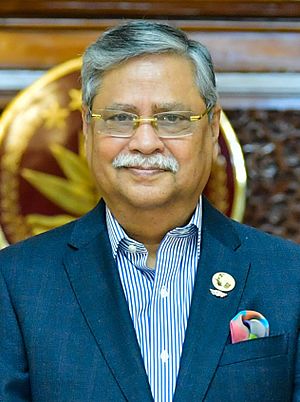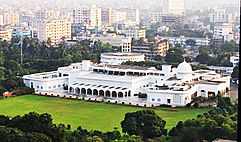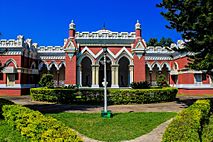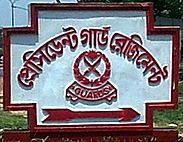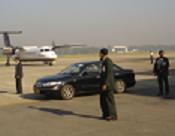President of Bangladesh facts for kids
The President of Bangladesh, officially known as the President of the People's Republic of Bangladesh, is the head of state of Bangladesh. This means they are the highest-ranking official representing the country. The President is also the commander-in-chief of the Bangladesh Armed Forces, which means they are in charge of the country's military.
The President's role has changed a few times since Bangladesh became independent in 1971. At first, presidents had a lot of power. But in 1991, Bangladesh became a parliamentary democracy, similar to the system in the United Kingdom. Now, the President's job is mostly ceremonial, meaning they perform important duties but the main decisions are made by the Prime Minister and Cabinet.
The President is chosen by the members of the Parliament. They usually represent the party that has the most seats in Parliament. The President lives and works at the Bangabhaban in Dhaka. They serve for five years and can be re-elected once.
Mohammed Shahabuddin became the President on April 24, 2023, after being elected without opposition on February 13, 2023.
Quick facts for kids President of the People's Republic of Bangladesh |
|
|---|---|

Standard of the president
|
|
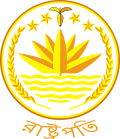
Seal of the president
|
|
| Head of state of the People's Republic of Bangladesh Executive branch of the Government of Bangladesh |
|
| Style |
|
| Abbreviation | POB |
| Residence | Bangabhaban |
| Appointer | All Members of Parliament |
| Term length | Five years,
renewable once
|
| Constituting instrument | Constitution of Bangladesh (1972) |
| Precursor | Governor of East Pakistan |
| Inaugural holder | Bangabandhu Sheikh Mujibur Rahman |
| Formation | 17 April 1971 |
| Deputy | Vice President of Bangladesh |
| Salary | ৳4140000 (US$44,000) per year (incl. allowances) |
Contents
What Does the President Do?
Even though the President's role is mostly ceremonial, they still have important duties. The Constitution says the President must follow the advice of the Prime Minister and the Cabinet.
Appointing Key Officials
The President has the power to appoint several important people:
- The Prime Minister and the Cabinet members. The Prime Minister must be a member of Parliament who has the support of most lawmakers. The President can also remove a Cabinet member if the Prime Minister asks.
- The chief justice and other judges of the court.
- The members of the Bangladesh Election Commission, including its chief.
Granting Pardons
The President can grant a pardon to anyone. This means they can cancel any court verdict in Bangladesh. This power is given by Article 49 of the Constitution.
Legislative Powers
The President plays a role in making laws.
- By Article 80, the President can send a bill passed by Parliament back for review. A bill only becomes law after the President approves it.
- However, if Parliament passes the bill again, it will automatically become law after a certain time, even if the President does not approve it again.
Chancellor of Universities
The President of Bangladesh is also the Chancellor of all universities in the country. This is an honorary position. For private universities, this is set by law. For public universities, it's a tradition.
How is the President Chosen?
Who Can Be President?
The Constitution of Bangladesh lists the requirements to become President:
- A person must be at least 35 years old.
- They must be qualified to be a member of Parliament.
- They cannot have been removed from the office of President by impeachment before.
Rules for Serving as President
There are also rules about how long someone can serve:
- No person can be President for more than two terms, even if those terms are not one after another.
- The President cannot be a member of Parliament. If a member of Parliament is elected President, they must give up their seat in Parliament on the day they become President.
The Election Process
When the President's office becomes empty, members of Parliament choose the new President. While there is a vote, members usually vote for the candidate their party supports. The President can also be removed from office through a process called impeachment. This requires a two-thirds majority vote by Parliament.
Taking the Oath
Before starting their job, the President must take an oath. They promise to protect, preserve, and defend the Constitution. They also promise to be fair to all people.
Presidential Immunity
The President has immunity for their actions while in office. This means they cannot be sued or charged with crimes for things they do as President. The only exception is if Parliament decides to impeach the President.
What Happens if the President Can't Serve?
If the President is absent due to illness or other reasons, the speaker of the Jatiya Sangsad (the head of Parliament) acts as President. This continues until the President can return to office.
Bangladesh does not have a vice-president because it is a parliamentary system. In the past, when Bangladesh had a presidential system, there was a vice-president who would take over if the President was absent. This position was removed in 1991.
How Can a President Be Removed?
A President can resign by writing a letter to the speaker of Parliament. The President can also be impeached by Parliament. If Parliament wants to impeach the President, they must make specific charges and investigate them. The President has the right to defend themselves. If two-thirds of Parliament votes in favor of impeachment, the President is removed, and the speaker takes over.
Where Does the President Live and Work?
The main official residence and office of the President is the Bangabhaban in Dhaka. There is also another presidential palace called Uttara Ganabhaban in Natore District, which is used as a retreat.
- Presidential amenities
-
Bangabhaban, official residence of the president, located at Dhaka.
A Brief History of the Office
Early Years and Parliamentary Republic (1971–1975)
During the Bangladesh Liberation War in April 1971, the first government of Bangladesh was formed. Sheikh Mujibur Rahman was the first President. He was a very popular leader. After the war ended, he became Prime Minister. In 1972, Bangladesh adopted a new constitution, making it a parliamentary republic. This meant the Prime Minister held most of the power.
Later, in 1974, Mohammad Mohammadullah became the ceremonial President. Sheikh Mujibur Rahman is known as the "Father of the Nation" for Bangladesh. He focused on building the new country, helping refugees, and improving education and healthcare. He also worked to get Bangladesh recognized by other countries and join international groups like the United Nations.
Presidential System and Changes (1975–1991)
In 1975, Sheikh Mujibur Rahman changed the system back to a presidential one, where the President had more power. He aimed to bring all political groups together for the country's unity.
After some political changes, Khondaker Mostaq Ahmad became President. Then, Chief Justice Abu Sadat Mohammad Sayem took over as head of a temporary military government.
Ziaur Rahman (Bangladesh Nationalist Party)
Major General Ziaur Rahman, a war hero, became President in 1977. He was the first directly elected President. He allowed more political parties to operate and held elections. His government made changes to the constitution, adding references to faith in God and emphasizing "Bangladeshi nationalism." He also worked to improve Bangladesh's relationships with other countries, especially those in the Middle East and China, which helped the country's economy and military. He also helped start SAARC, a group for regional cooperation in South Asia.
In 1981, Ziaur Rahman passed away. Vice-President Justice Abdus Sattar became acting President and was later elected.
Hussain Muhammad Ershad (Jatiya Party)
In 1982, Lt. Gen. H.M. Ershad took power. He became President in 1983. He also formed a new political party, the Jatiyo Party. Ershad was elected President in 1986. During his time, Parliament passed a law making Islam the state religion.
By 1990, there was strong opposition to Ershad's rule, and he resigned. An interim government was formed, and Chief Justice Shahabuddin Ahmed became acting President. He held new elections in 1991.
Return to Parliamentary System (1991–Present)
In 1991, Bangladesh returned to a democratic parliamentary system. Khaleda Zia became the first female Prime Minister.
Today, the President is the head of state, and their role is mostly ceremonial. However, the President's powers increase significantly during the time of a caretaker government. A caretaker government is a temporary, non-political government that takes over to ensure fair elections and a smooth transfer of power. This system was first used in Bangladesh in 1991 and made official in 1996.
During a caretaker government, the President has more control, including over the Ministry of Defence. They can also declare a state of emergency and dismiss members of the caretaker government. Once a new government is elected, the President's powers return to their usual ceremonial role.
See also
 In Spanish: Presidente de Bangladés para niños
In Spanish: Presidente de Bangladés para niños
- List of presidents of Bangladesh
- Prime Minister of Bangladesh
- Vice President of Bangladesh
- Deputy Prime Minister of Bangladesh
- Politics of Bangladesh
- Caretaker government
- Foreign Minister of Bangladesh


